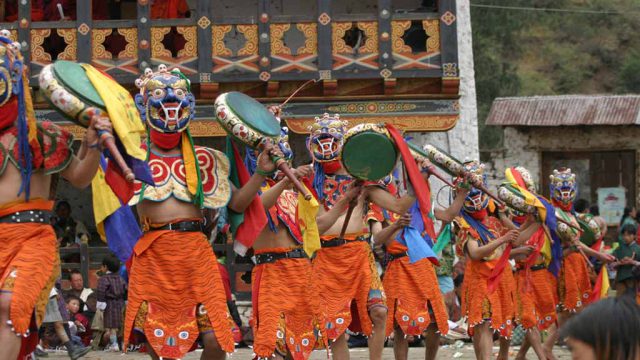Winter in Bhutan is the time for festivals. Many of the leading dzongs (fortresses, now administrative hubs) and monasteries hold the annual Tshechu festival at this time of the year. Cham or mask dance is a part of the Tshechu festivals. These colourful and energetic dance programmes are considered to provide protection from misfortune and exorcise evil influences. At many places, a thongdrol (which means ‘liberation on sight,’) – usually a large thangka or scroll – is revealed to confer blessings on those assembled. The Tshechu and other festivals are also seen as an occasion for families and friends to come together; people walk long distances to attend the festivals. Hence, arrive early at the dzong or monastery to secure a vantage point, especially if you are a photographer.
Monggar Tshechu
When: November 28 onwards
The new dzong of Monggar (eastern Bhutan) was established in 1953 by Bhutan’s King Jigme Dorji Wangchuck. The ruins of the older Zhongar Dzong lie next to the highway in Lingmethang before reaching Monggar. The annual Monggar Tshechu is held for three days. And when in Monggar, do not forget to check out the exquisite wood carvings.
Trashigang Tshechu
When: November 30 onwards
The majestic Trashigang dzong, built in the 17th century, is perched on a high ridge overlooking the two rivers, Dangme chu and Gamri chu. The annual Trashigang Tshechu festival is held during the 7th and the 11th days of the tenth month of the Bhutanese calendar (November/December). It is worthwhile to spend a few days here as preparations for the Trashigang Tshechu begin two days prior to the actual festival. On the 7th day, monks perform ceremonial ablutions and rehearsals on the 8th day. The main festival begins on the 9th day. On the 10th day, the Thongdrol of Neten Chudrug (Sixteen Arhats) is unfurled, and on the last or the 11th day, the old Thongdrol of Guru Tshengyed is displayed; a series of mask dances or chams are held on these two days.
Lhuntse Tshechu
When: 29 December onwards
The Lhuntse Tshechu is scheduled to start by late December. Located in one of the easternmost districts of Bhutan and near the Tibetan border, the Lhuntse Dzong sits high upon a ridge overlooking the Kuri chu. Visitors from near and far gather to watch the cham or the mask dance and to pay their respects to the sacred relics that are displayed during the three-day festival. Lhuntse is also famous for its unique textile, the Kushithara.
Trongsa Tshechu
When: December 30 – January 1
If you are looking to end the year in style and greet the New Year on a solemn note, head for central Bhutan’s Trongsa Dzong, which will observe its Tshechu festival between December 30, 2014 and January 1, 2015. Built in the mid-17th century, the ridge-top Dzong is a massive structure with many levels. Mask dances, unfurling the thongdrol and the display of the sacred Nangtens (relics) on the last day of the festival are some of the highlights that draw a large number of people to Trongsa.
For more information: www.tourism.gov.bt/




